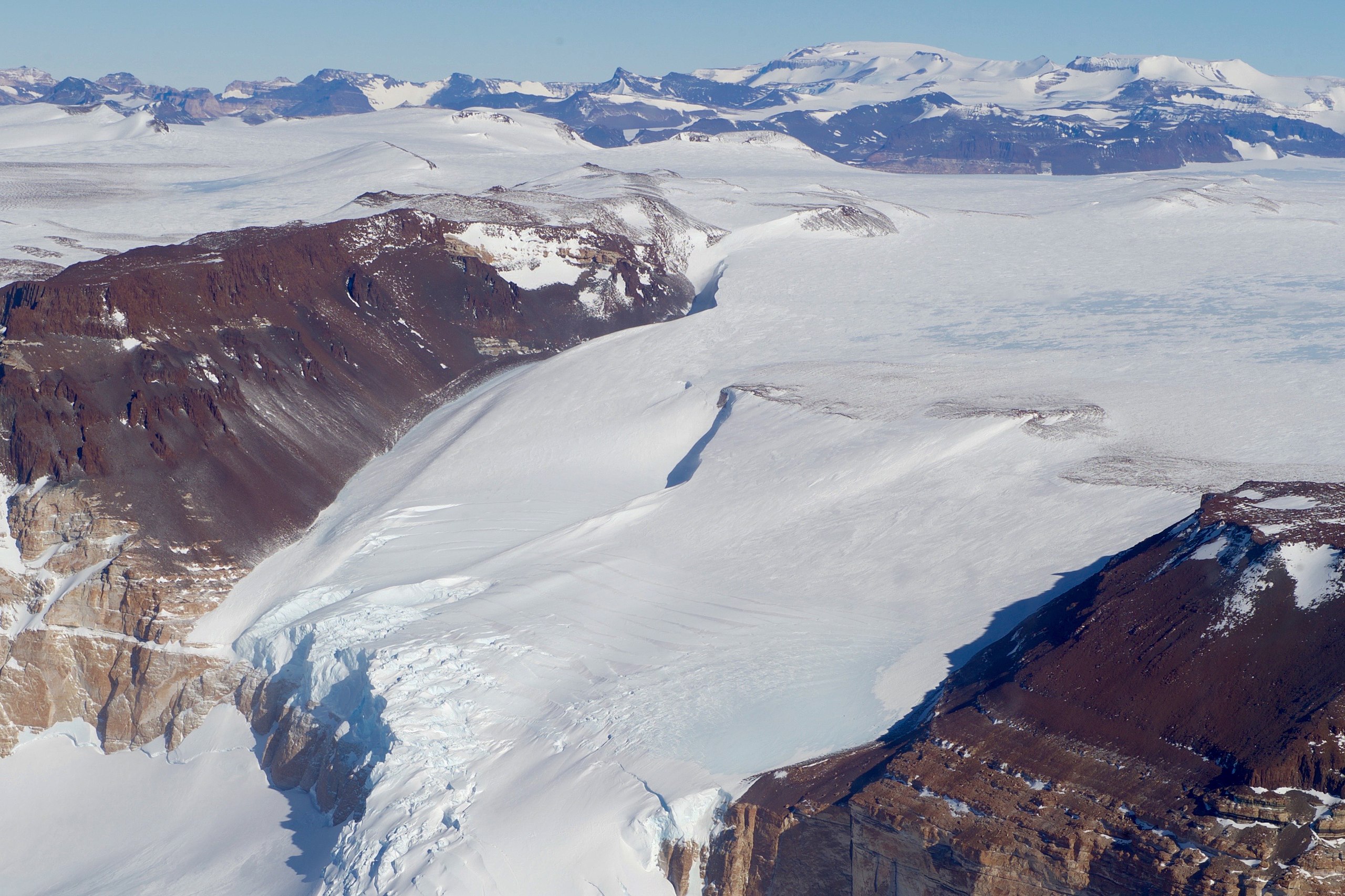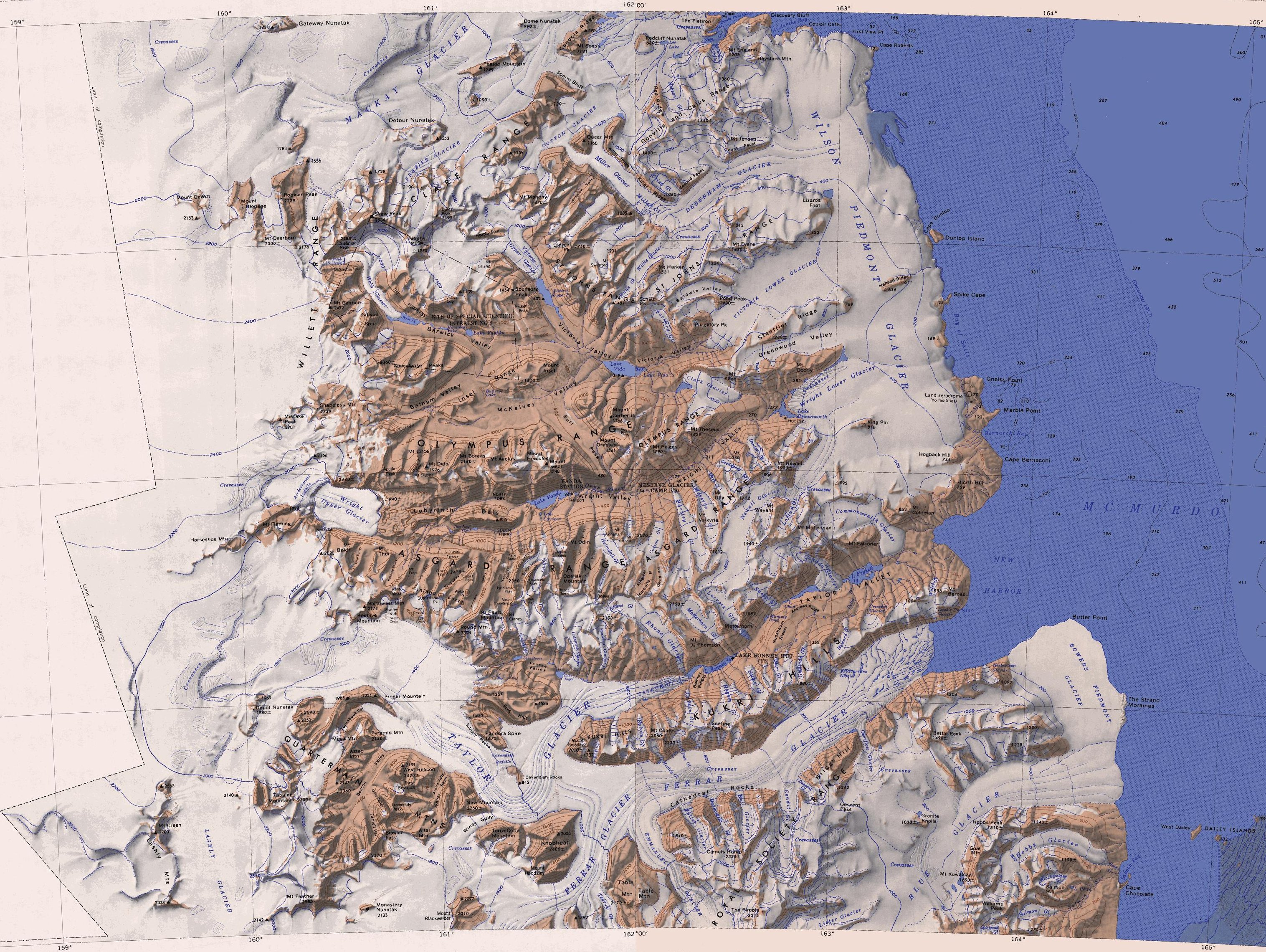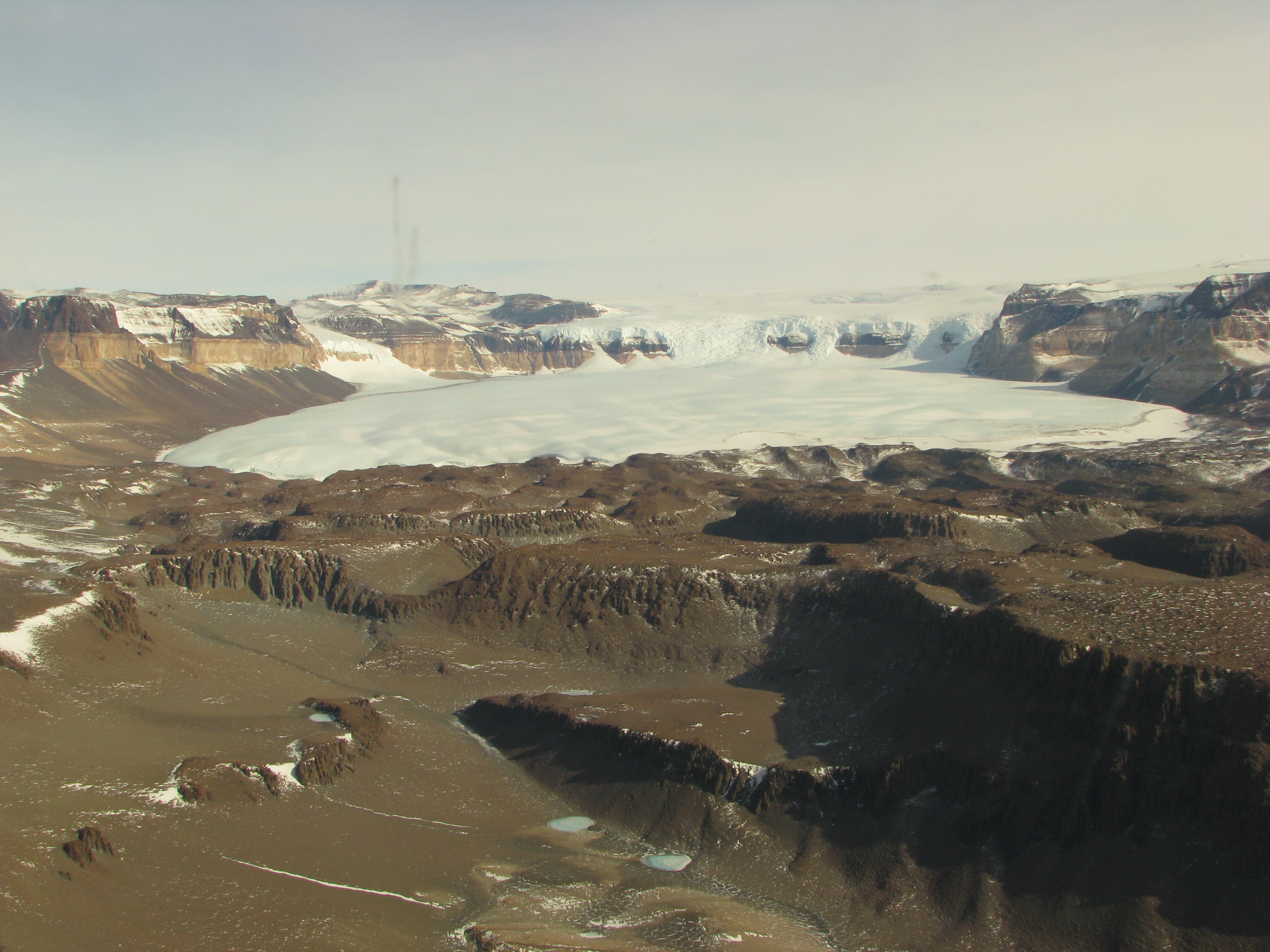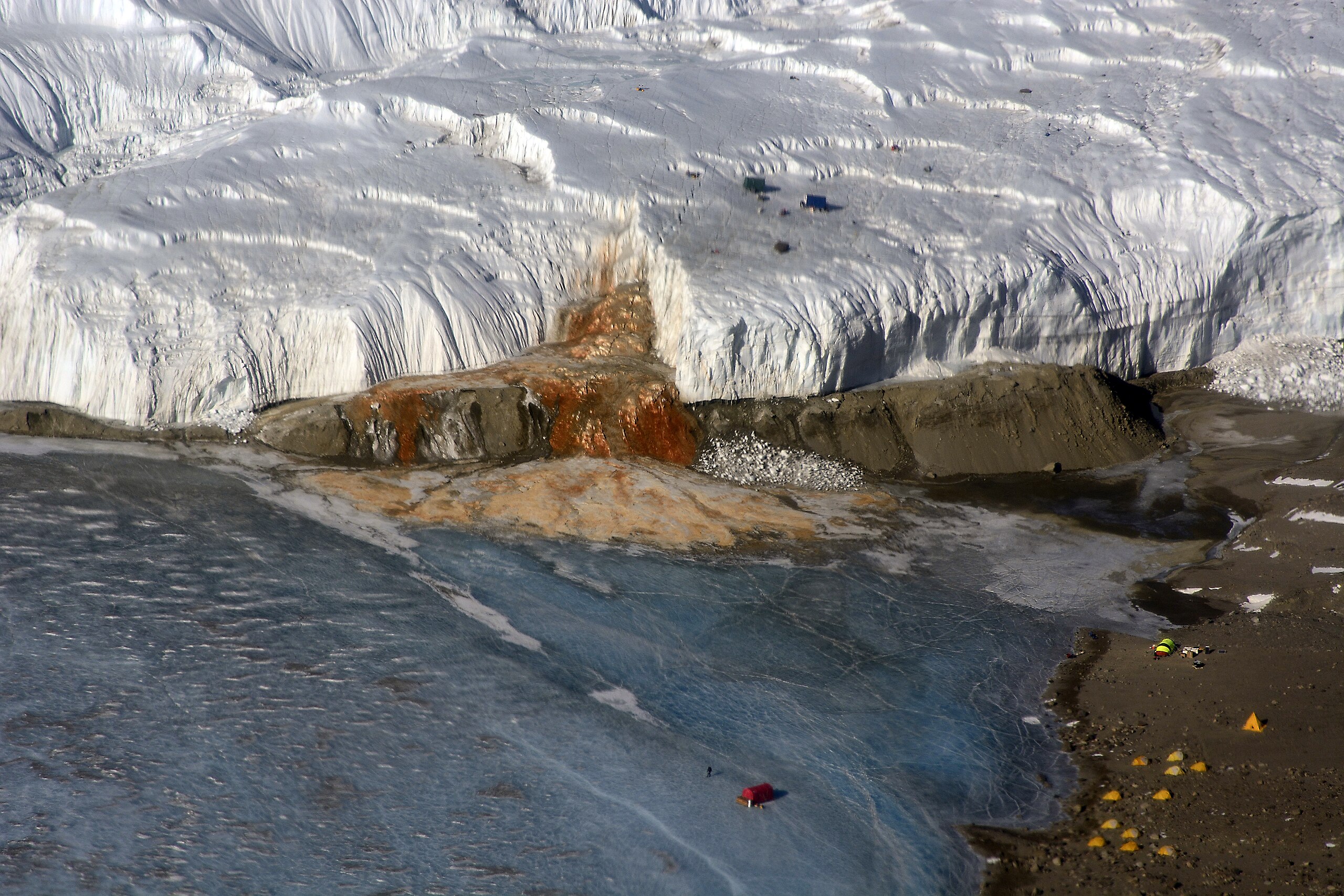
Credit: U.S. Department of State, public domain, via Wikimedia Commons
Background
Synopsis: The McMurdo Dry Valleys of Antarctica are one of the most desolate places in the world and are considered to be the closest environment to Mars on Earth. Despite this, microorganisms still thrive in the barren areas. These could give scientists a clue to what life on Mars and even on other planets could look like, and how it could survive such harsh conditions.
- In Antarctica, west of the McMurdo research base, there are places without snow or ice.
- These dry lands are called the McMurdo Dry Valleys, and they exist because the mountains surrounding them block precipitation and keep snow and ice from covering the ground.
- What little precipitation does fall gets blown away by harsh winds.
- The valleys were discovered in 1903, with the first scientific study of them in 1911.
- The valleys are one of Earth’s driest deserts, as covered in this previous EarthDate episode. However, during the months of December to March, the Antarctic summer, solar radiation produces glacial meltwater, which forms streams and rivers. And where there is water, there is life.

Snow is blocked by mountains, which shield the McMurdo Dry Valleys.
Credit: Olaf Studt, public domain, via Wikimedia Commons
The Wright Upper Glacier in the Wright Valley, McMurdo Dry Valleys.
Credit: Dturme, CC BY-SA 4.0, via Wikimedia Commons
- There are no plants, birds, or mammals in the McMurdo valleys, but there are many microorganisms living here.
- There are ice-covered lakes scattered in the valleys. The ice covers a stable water column and blocks much of the sun’s radiation, important since the sun doesn't set during this season.
- In these lakes, blue-green cyanobacteria, dark-colored to protect themselves from the harsh UV rays, grow in mats on the lake beds.
- These mats can get incredibly large. There is very little to disturb them and no grazing, so they can grow in annual layers.
- The lake levels in the McMurdo Dry Valleys are entirely dependent on glacial meltwater runoff. Lake Vanda, for example, has previously dried up completely, leaving behind only a brine pool that persists at the lake’s bottom today.
- There is even life within pockets of water inside the glaciers themselves, which flows out from the glacier at a spot named “Blood Falls.”
- Trapped within this glacier are the remains of an ocean from thousands of years ago.
- This water has become highly saline and completely devoid of oxygen and, owing to its salinity, is constantly colder than the freezing point of pure water.
- Despite this, microbes now call this pocket of ancient ocean home, mostly protobacteria and other microorganisms related to marine organisms.
- These organisms metabolize sulfur and iron to produce their energy. Some scientists theorize the iron comes from the glacier scraping against rocks.
- The iron colors the water red-orange, which stains the glacier when it flows out.

Blood Falls at the terminus of Taylor Glacier in the McMurdo Dry Valleys, releasing iron-rich brine into Lake Bonney.
Credit: Peter Rejcek, NSF, public domain, via Wikimedia Commons
- However, there is not only life in the water of the McMurdo Dry Valleys, but also in the stretches of exposed soil.
- Microbes and microscopic soil invertebrates have created communities in the valleys, and their populations are changing as the Antarctic climate warms.
- The melting and thawing of ice and permafrost has led to a decline in some nematode species, a type of roundworm that has been covered in a prior EarthDate episode, while some species are becoming more abundant or migrating to a higher elevation.
- This means that uphill areas are becoming more biologically diverse, and the consequences of this are still unknown.
- These hardy microorganisms can survive such harsh conditions and normally can live up to ten years, but it is unclear how they will respond to warming temperatures and weather disturbances.
- The McMurdo Dry Valleys are considered to be the most similar environment on Earth to Mars.
- Researchers investigate the geology, weather, climate, and life forms of the area, to speculate about life on other planets.
- Since there are microorganisms left in the soil of the valleys after water or ice has evaporated, it’s possible they remain in similar dry conditions on other planets.
Episode script
The most extreme, most inhospitable lands on Earth are the McMurdo Dry Valleys, near the coast of Antarctica, just inland from the McMurdo science base.
We normally think of Antarctica as covered in ice. But the dry valleys are surrounded by mountains, which block precipitation. What little water does accumulate is blown away by the constant winds.
And yet, there is life.
From December to March, the Antarctic summer, 24-hour sunshine melts ice in the mountains, producing meltwater streams that trickle into the valleys. They fill shallow, ice-covered lakes, in which microorganisms thrive.
When the water evaporates, some of those micro-critters continue to live in brine pools. Others persist in the soil.
Others live inside the glaciers that surround the valleys. That’s because trapped within them are the remnants of an ancient ocean. The water is too salty to freeze, and devoid of oxygen.
But the microbes metabolize sulfur and iron, which may come from the glaciers scraping over iron-rich rocks as they move.
One of the glaciers terminates in the dry valleys, where it secretes its red brine at Blood Falls.
Scientists believe this frigid hellscape, blasted by wind and blistering UV rays, is the closest environment on Earth to Mars.
So they’re studying it, to learn how life can survive here -- and how it might survive on the Red Planet itself.

